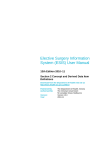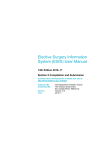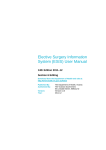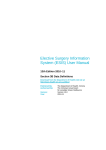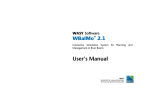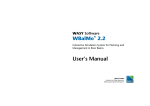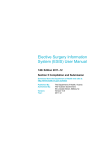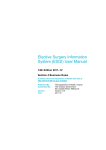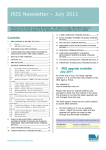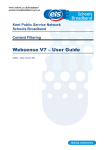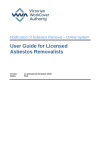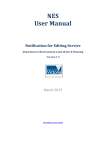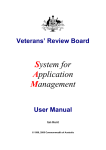Download Victorian Emergency Minimum Dataset (VEMD) User Manual
Transcript
Elective Surgery Information System (ESIS) User Manual 13th Edition 2010–11 Section 3A Data Definitions Download from the Department of Health web site at: http://www.health.vic.gov.au/hdss/ Published By: Authorised By: Version: Year: The Department of Health, Victoria The Victorian Government 50 Lonsdale Street, Melbourne Version 13.0 2010-11 ESIS Manual Sections The Elective Surgery Information System (ESIS) Manual sections are: Click Section Number Glossary Section 1 Please follow the arrow and click the manual section number you require. Lists the terms and abbreviations used in the ESIS manual. ESIS Manual Introduction Provides information on the development and purpose of the ESIS data collection, scope and coverage, contact details and a list of relevant abbreviations. Section 2 Concept and Derived Item Definitions Provides definitions of concepts that are the foundation of the ESIS collection and information that the department derives from the data submitted. Section 3a Data Definitions Details the specifications of data items relating to individual waiting episodes for reporting to ESIS. Section 3b Section 4 Details the technical or database elements required for submission of ESIS data. Business Rules Draws together a number of concepts and data items as well as describing the technical functions of the ESIS processing. Section 5 Compilation and Submission Specifies the required format of ESIS records submitted to AED. It includes details such as file naming conventions, file structures, reporting requirements, data security, test submission and system migration. Section 7 Editing Each ESIS edit message is listed in this section in numerical order. The entry for each edit message describes the problem and the remedy. Section 8 Supplementary Code Lists http://www.health.vic.gov.au/hdss/reffiles/index.htm Contents SECTION 3A: Data Definitions 1 Data Definition Structure 1 Data Items 3 Administrative Registration Date 3 Clinical Registration Date 4 Clinical Urgency 6 Date of Admission 8 Date of Birth 9 Date of Birth Accuracy Code 10 Destination 12 Indigenous Status 14 Insurance Declaration 16 Locality 18 Medicare Number 20 Medicare Suffix 22 Multi-attribute Prioritisation Tool (MAPT) Score 24 Patient Identifier 26 Planned Length of Stay 27 Postcode 28 Previous Identifier of Transferred Episode 30 Principal Prescribed Procedure 31 Principal Prescribed Procedure Description 33 Readiness for Care 34 Reason for Removal 36 Reason for Scheduled Admission Date Change 42 Removal Date 47 Scheduled Admission Date 49 Sex 51 Source of Referral 53 Surgical Speciality 55 Treatment Campus 57 SECTION 3A: Data Definitions Section 3a details the related ESIS collection data elements in the data collection. Note: Section 3b sets out the technical or database items required for the submission of ESIS data. Sites and software vendors should be aware that this manual describes how data should be submitted to the Department of Health and not how they are stored in a site’s system. Sites should map from their stored values to the specified ESIS values. Data Definition Structure Specification Definition A statement that expresses the essential nature of a data item. Label The first row of a field in a text extract. Labels represent field names. Field Size The maximum number of characters accommodated by this field. Valid Values The title of the Code set valid for this data item when these are not specifically listed in Section 3 of this Manual. Code sets not listed in Section 3 of this Manual are available from: http://health.vic.gov.au/hdss/reffiles/index.htm Layout X Alpha or Numeric character in range A-Z, a-z, 0-9 DD Numeric characters representing day of the month. Leading zero filled. Range 01-31. MM Numeric characters representing month. Leading zero filled. Range 01-12. YYYY Numeric characters representing year. A Alpha character in range A-Z, a-z N Numeric character in range 0-9 Reported in The specific text extract in which this data item is submitted to ESIS. Reported for The specified circumstances when this data item must be reported. Reported when The stage in the episode/data submission cycle when this data item is to be reported to ESIS. Code set The valid values for the data item (current financial year only). Reporting guide Additional comments or advice on reporting the item. Edits A list of edits (edit numbers and titles) that relate to this data item Related items A reference to related data items within this collection ESIS Manual: 13th Edition – Section 3A: Data Definitions Page 1 Administration Purpose The main reason/s for the collection of this data item. Principal data users Identifies the key/primary users of this information. Collection start The date the collection of this data item commenced. Version A version number for each data item, beginning with 1 for the initial version of the data item and incremented by one, for each subsequent revision. A new version number is allocated to a data item when changes have been made to one or more of the following attributes: Name, Definition or Code set. Definition source Identifies the authority that defined this data item and the unique identifier for the data item if applicable. Code set source Identifies the authority that developed the code set for this data item. ESIS Manual: 13th Edition – Section 3A: Data Definitions Page 2 Data Items Administrative Registration Date Specification Definition The date that the waiting list episode is first entered on the reporting health service waiting list system. Label Administrative_Registration_Date Field Size 8 Layout DDMMYYYY Reported in Episode extract Reported for All waiting list episodes registered on or after 1 July 2005. Reported when The Waiting List episode is first reported. Reporting guide The Administrative Registration Date will be on or after the date of the Clinical Registration Date. It should be an automatic date stamp of the date of data entry. Because this date should reflect the system's processing date it cannot be updated once reported. An episode may commence and conclude before staff has had a chance to enter it into the system. The Administrative Registration Date will be the date on which the data entry was actually performed. Edits Related items Administration Purpose S315 Clinical Urgency Cat 1, Wait More Than 30 days S422 Clinical Registration Date after Administrative Registration Date S423 Administrative Registration Date has changed S424 Administrative Registration Date Invalid Section 2 Registration Date-Administrative Registration Date-Clinical Section 3a Clinical Registration Date To determine the duration between a doctors referral to the waiting list and the time that the patient’s details are entered onto the health service waiting list. To enable close compliance with national reporting requirements. Principal data users Department of Health Collection start July 2005 Definition source Department of Health Based on Listing Date for Care (METeOR Id 269957) Version ESIS Manual: 13th Edition – Section 3A: Data Definitions 1 (Effective 1 July 2005) Page 3 Clinical Registration Date Specification Definition The date of the clinical assessment at which it was agreed that surgery was required, and the relevant referral paperwork completed by the clinician. Label Clinical_Registration_Date Field Size 8 Layout DDMMYYYY Reported in Episode extract Reported for All waiting list episodes. Reported when The episode is first registered on the waiting list. Reporting guide Where data entry of a patient’s waiting episode takes place after the date on which the need for a procedure is identified, the Clinical Registration Date should be backdated. The Clinical Registration Date remains the date on which the need for a procedure to treat a clinical condition is identified, even where the ‘Consent for Surgery’ form has not been signed and the administrative registration process is delayed because of this. For further information regarding the registration process refer to the Elective Surgery Access Policy available from: http://health.vic.gov.au/elective surgery Changes to Clinical Registration Date The Clinical Registration Date may only be altered if a data entry error has occurred. Clinical Registration After Admission Sites that use their booking system to schedule procedures for patients who are currently admitted, and who will receive the awaited procedure in the same admission should ensure that these episodes are not reported to ESIS as they are not within the scope of this data collection. Transferred waiting episode from another ESIS hospital The Clinical Registration Date for a transferred waiting episode (as reported by the receiving hospital) is the ‘agreed transfer date’. Refer to Section 4: Transfer of Ownership of Waiting episode for further information about transfers. Edits S099 Clinical Registration Date before Date Of Birth S135 Patient Already on Waiting List for same PPP S169 Clinical Registration Date Invalid S174 New Episode, Old Clinical Registration Date S291 Removal Date Is Before Clinical Registration Date S311 Wait Equals Five Years Or More S315 Clinical Urgency Cat 1, Wait More Than 30 days ESIS Manual: 13th Edition – Section 3A: Data Definitions Page 4 Related items Administration Purpose S388 Clinical Registration Date Has Changed S397 Unmatched Transfer As Reported By Receiving Health Service S422 Clinical Registration Date After Administrative Registration Date Section 2 Registration—Administrative Registration—Clinical Total Waiting Time Section 3a Administrative Registration Date. Used for waiting time calculations. To determine the duration between a doctors referral to the waiting list and the time that the patient’s details are entered onto the health service waiting list. Principal data users Department of Health, AIHW and the Commonwealth Department of Health and Aged Care. Collection start July 1997 Definition source Department of Health Version ESIS Manual: 13th Edition – Section 3A: Data Definitions 3 (Effective 1 July 2005) Page 5 Clinical Urgency Specification Definition A clinical assessment of the urgency with which a patient requires elective hospital care. Label Event_Value Field Size N/A Reported in Intra Episode extract Reported for All waiting list episodes. Reported when The waiting list episode is first registered and each subsequent urgency categorisation. Code set Code Descriptor 1 URGENT Admission within 30 days of clinical assessment desirable for a condition that has the potential to deteriorate quickly to the point that it may become an emergency. 2 SEMI-URGENT Admission within 90 days of clinical assessment desirable for a condition causing some pain, dysfunction or disability but is not likely to deteriorate quickly or become an emergency. 3 NON-URGENT Admission at some time in the future acceptable for a condition causing minimal or no pain, dysfunction or disability, that is unlikely to deteriorate quickly, and does not have the potential to become an emergency. Intra Episode Event Reporting guide Event Type Urgency Event Date Date that the clinician assigned or re-categorised the patients’ Clinical Urgency. Urgency categorisation is based on factors such as the degree of pain, dysfunction and disability caused by the condition and its potential to deteriorate quickly into an emergency. Clinical Urgency categorisation is a clinical decision that may only be made by the clinician responsible for the patient’s treatment, whether it is that patient’s specialist, the head of the unit (or his/her delegate) or an appropriate panel of surgeons. A patient’s Clinical Urgency may change if he or she undergoes clinical review during the waiting period. The need for clinical review varies with the patient’s condition and is therefore at the discretion of the treating clinician. There can be only one Urgency Event per episode per day. For further information regarding the clinical urgency process refer to the Elective Surgery Access Policy available from: http://health.vic.gov.au/elective surgery ESIS Manual: 13th Edition – Section 3A: Data Definitions Page 6 Edits Related items Administration Purpose S315 Clinical Urgency Cat 1, Wait More Than 30 Days S375 Clinical Urgency Category For ESAS Reason For Removal Invalid S383 Multiple Events Of Same Type For Same Episode On One Day S384 Invalid Event Date S385 Invalid Event Type S389 Invalid Intra Episode Event Value For Clinical Urgency Change S412 Episode Registered Without A Clinical Urgency S429 SAD Identifier/Event Type Mismatch Section 2 Intra Episode Event Urgency Reassignment (Recategorisation). Section 3b Event Date Event Type Event Value Section 4 Intra Episode Events Required for Registration. Allows hospitals to prioritise patients waiting for elective surgery based on their clinical urgency. Provides an indicator for monitoring patients who wait in excess of the maximum desirable time for their elective surgery. Principal data users Department of Health, AIHW and the Commonwealth Department of Health and Aged Care. Collection start July 1997 Version Definition source NHDD (METeOR Id 270008) Code set source ESIS Manual: 13th Edition – Section 3A: Data Definitions 1 (Effective 1 July 1997) NHDD Page 7 Date of Admission Specification Definition Date on which an admitted patient commences an episode of care during which the patient receives the awaited procedure. Label Date_Of_Admission Field Size 8 Layout DDMMYYYY Reported in Episode extract Reported for Episodes where the patient has received the awaited procedure. (Reason for Removal codes W, M, Y, B, I, U, S, X). Reported when The patient is admitted for, and has received, the awaited procedure for this waiting episode. Reporting guide Report the Date of Admission for all waiting episodes where the patient has received the awaited procedure. The Date Of Admission will be on or before the Removal Date. Do not report any scheduling that occurs after the Date Of Admission. Edits Related items Administration Purpose S295 Date Of Admission Not Equal To Scheduled Admission Date S399 Date Of Admission For Awaited Procedure But No Removal Date S400 Date Of Admission For Awaited Procedure Invalid S401 Date Of Admission/Reason For Removal Mismatch S403 Date Of Admission For Awaited Procedure Is After Removal Date Section 3a Reason For Removal, Removal Date. Calculation of key performance indicators under Performance Monitoring Framework. Principal data users Performance Acute Programs and Rural Health, Department of Health. Collection start July 2005 Version 1 Definition source July 2005 Code set source N/A ESIS Manual: 13th Edition – Section 3A: Data Definitions (Effective 1 July 2005) Page 8 Date of Birth Specification Definition The date of birth of the person. Label Date_Of_Birth Field Size 8 Layout DDMMYYYY Reported in Patient extract Reported for All patient level records. Reported when The patient is first registered on the waiting list. Reporting guide The Date of Birth must be on or before the Clinical Registration Date. Unknown Date Of Birth If the patient’s Date of Birth is unknown, the patient’s approximate age should be used to estimate the year of birth. Sentinel dates should not be used. Edits Related items Administration Purpose S096 Date Of Birth Invalid S099 Clinical Registration Date Before Date Of Birth S409 Age Greater Than 105 Years Section 2 Age Section 3a Date of Birth Accuracy Code. Used to derive age for demographic analyses. Principal data users Department of Health Collection start July 1997 Definition source NHDD (METeOR Id 287007) Version ESIS Manual: 13th Edition – Section 3A: Data Definitions 1 (Effective 1 July 1997) Page 9 Date of Birth Accuracy Code Specification Definition A code representing the accuracy of the components of a date - day, month, year. Label DOB_Accuracy_Code Datatype Alpha Field Size 3 Layout AAA Reported in Patient extract Reported for All patient level records. Reported when The patient is first registered on the waiting list. Value domain Value domain consists of a combination of three codes, each of which denotes the accuracy of one date component: Reporting guide Form Structured Code Code Descriptor A The referred date component is accurate. E The referred date component is not known but is estimated. U The referred date component is not known and not estimated. Component Descriptor 1st – D Refers to the accuracy of the day component. 2nd – M Refers to the accuracy of the month component. 3rd - Y Refers to the accuracy of the year component. Any combination of the values A, E, U representing the corresponding level of accuracy of each date component of the reported date. Where possible, report the accuracy of each date component. However, where software systems allow the collection of a binary value for Date of Birth Accuracy (that is the system has an ‘Estimated Date of Birth’ check box or similar) values such as ‘AAA’ and ‘EEE’ will be acceptable. It is understood that the Date of Birth Accuracy Code will be reported as ‘AAA’ unless the date has been flagged as an estimated date. It is not necessary to validate the Date of Birth provided by every patient unless there is a reasonable suspicion that the date provided is not correct. Where there is a question over the date provided, or where the patient is unable or unwilling to provide their date of birth, the date should be estimated and flagged as such. If the date of birth is provided by a reliable source (for example the patient or close relative) and is known as accurate then the date accuracy indicator should be reported as ‘AAA’. ESIS Manual: 13th Edition – Section 3A: Data Definitions Page 10 Reporting guide (Cont’d) If the patient’s approximate age is known, then this should be used to calculate an estimated year of birth. Sentinel dates should not be used. The Date of Birth Accuracy code would be reported as ‘UUE’, that is the day and month are ‘unknown’ and the year is ‘estimated’. A Year component value of U – Unknown is not acceptable. Where the date part is accurate or estimated, the date part cannot be ‘00’. Where the date part is unknown, the date part may be ‘00’ or ‘NN’. Examples: Valid combinations include: DOB Accuracy = ‘AAA’, DOB = ‘03/11/1956’ DOB Accuracy = ‘EEE’, DOB = ‘03/11/1956’ DOB Accuracy = ‘UUE’, DOB = ‘00/00/1945’ DOB Accuracy = ‘UUE’, DOB = ‘01/01/1945’ Invalid combinations include: DOB Accuracy = ‘AAA’, DOB = ‘00/00/1956’ DOB Accuracy = ‘AAA’, DOB = ‘00/06/1956’ DOB Accuracy = ‘EEE’, DOB = ‘00/00/1956’ DOB Accuracy = ‘UUE’, DOB = ‘00/00/0000’ DOB Accuracy = ‘UEE’, DOB = ‘00/00/1956’ Edits S432 Invalid Date of Birth Accuracy code. Related items Section 2 Age Section 3a Date of Birth. Administration Purpose Required to derive age for demographic analyses and for analysis by age at a point of time. Principal data users Multiple internal and external research users. Collection start 2008-2009 Definition source NHDD (Department of Health modified) Value Domain source NHDD Date-Accuracy Indicator (METeOR Id 294429) ESIS Manual: 13th Edition – Section 3A: Data Definitions Page 11 Destination Specification Definition Identification of the Campus: that is accepting responsibility for the patient’s waiting episode or where the patient is receiving treatment under contract or similar arrangement. Label Destination Field Size N/A Layout Valid Values Reported in Episode extract Reported for Episodes removed from the waiting list with a Reason for Removal of N, T, S, X. Reported when The patient is removed from the waiting list. Reporting guide Patients treated at another hospital, arranged by ESAS Code from Campus Codes code set or blank A patient treated at another hospital, arranged by ESAS, is not considered to be a transfer of the waiting episode, because the responsibility for the patient’s waiting episode remains with the original hospital. In order to identify where the patient has received treatment report the Destination code for the treating campus. Patients who are treated under other contract or similar arrangement at another hospital (public or private) A patient treated under other contract or similar arrangement at another hospital (public or private), arranged by this hospital, is not considered to be a transfer of the waiting episode because the reporting responsibility for the patient’s waiting episode remains with the contracting hospital. In order to identify where the patient has received treatment, report the Destination code for the treating campus. Includes: Patients treated under Hub and spoke arrangement where the Hub retains responsibility for the patient’s waiting episode. Patients who elect to be treated in a private hospital Where a patient elects to be treated in a private hospital and this has not been arranged by this hospital, this is not considered to be a transfer of the waiting episode. In this instance, the patient should be removed from the waiting list with a removal code of I. Do not report a Destination code. Invalid Destination / Reason for Removal Combination Edits S310 Related items Section 2 Elective Surgery Access Service Section 3a Reason for Removal. ESIS Manual: 13th Edition – Section 3A: Data Definitions Page 12 Administration Purpose Used for analysis of service delivery patterns. Principal data users Department of Health Collection start July 1999 Version 5 Definition source Department of Health Code set source Department of Health ESIS Manual: 13th Edition – Section 3A: Data Definitions (Effective 1 July 2005) Page 13 Indigenous Status Specification Definition An Aboriginal or Torres Strait Islander is a person of Aboriginal or Torres Strait Islander descent who identifies as an Aboriginal or Torres Strait Islander and is accepted as such by the community in which he or she lives. Label Indigenous_Status Field Size N/A Layout Valid values Reported in Patient extract Reported for All patient level records Reported when The waiting list episode is first registered and whenever the field is updated. This field should be updated on each occasion that any other demographics are updated. Code set Code Descriptor 1 Indigenous - Aboriginal but not Torres Strait Islander origin. 2 Indigenous - Torres Strait Islander but not Aboriginal origin. 3 Indigenous - Aboriginal and Torres Strait Islander origin. 4 Not-indigenous – Not Aboriginal or Torres Strait Islander origin. 8 Question unable to be asked. 9 Patient refused to answer. Reporting guide Code from Indigenous Status code set A person of Aboriginal descent is a person descended from the original inhabitants of Australia. The Torres Strait Islands are the islands directly to the north of Cape York, between Cape York and New Guinea. In Victoria, the community of Torres Strait Island people is small and the community of Aboriginal and Torres Strait Island people is smaller again, therefore code 2 Indigenous Torres Strait Islander but not Aboriginal origin and code 3 Indigenous Aboriginal and Torres Strait Islander origin would not be widely used. Code 8 Question unable to be asked should only be used under the following circumstances: When the patient’s medical condition prevents the question of Indigenous Status being asked. In the case of an unaccompanied child who is too young to be asked their Indigenous Status. Where registration for a waiting list episode occurs without the patient being present and cannot be determined from the information supplied. In this case it is expected that Indigenous Status will be updated prior to or at admission. ESIS Manual: 13th Edition – Section 3A: Data Definitions Page 14 Note: Systems must not be set up to input a default code. Rather than asking every patient about his or her Indigenous Status, first ask the patient: ‘Were you born in Australia?’ If the answer to the question, ‘Were you born in Australia’, is ‘No’: Ask the patient: ‘What country were you born in?’ However, if the answer is ‘Yes’ Ask the patient: ‘Are you of Aboriginal or Torres Strait Islander origin?’ If the patient answers, ‘Yes’ to being of Aboriginal or Torres Strait Islander origin, then ask further questions to record correctly the person's indigenous status. Patient is baby or child The parent or guardian should be asked about the Indigenous Status of the child. If the mother of a newborn baby has not identified as being of Aboriginal or Torres Strait Islander descent, hospital staff should not assume the baby is non-Aboriginal; the father may be of Aboriginal or Torres Strait Islander descent. For further information refer to the Principles of recording Aboriginal Status in Victoria available on the internet at: http://www.health.vic.gov.au/koori/ Edits Administration Purpose S425 Indigenous Status Invalid. To: enable planning and service delivery, and monitoring of indigenous health at state and national level, facilitate application of specific funding arrangements. Principal data users Koori Health Unit (Public Health, Department of Health) Collection start July 2005 Version 2 Definition source NHDD (METeOR Id 291036) Code set source NHDD (Department of Health modified) ESIS Manual: 13th Edition – Section 3A: Data Definitions (Effective 1 July 2008) Page 15 Insurance Declaration Specification Definition The patient’s insurance election, for a given episode. Label Insurance_Declaration Field Size N/A Layout Valid values Reported in Episode extract Reported for Mandatory for all episodes where the patient has received the awaited procedure and the patient was either admitted to this Health Service/r Campus or the admission was arranged by this Health Service/Campus. (Reason For Removal code of W, M, Y, S, X). Reported when The patient is removed from the waiting list (mandatory). May be reported at any time during the waiting episode. Code set Code Descriptor M Public P Private V Department of Veterans Affairs W Worksafe Victoria T Transport Accident Commission A Armed Services S Seamen C Common Law Recoveries O Other Compensable X Ineligible Reporting guide Code from Insurance Declaration code set If the episode is not removed, the Insurance Declaration reflects the patient’s intended insurance election for that episode. If the intended Insurance Declaration changes, the episode record should re-sent to update the episode record already at Department of Health. Prisoners For prisoners report X Ineligible. Insurance Declaration Invalid. Edits S303 Related items Section 3a Reason for Removal ESIS Manual: 13th Edition – Section 3A: Data Definitions Page 16 Administration Purpose Analysis of utilisation and health care financing. Principal data users Department of Health Collection start July 1997 Version 4 Definition source Department of Health Code set source Department of Health ESIS Manual: 13th Edition – Section 3A: Data Definitions (Effective 1 July 2005) Page 17 Locality Specification Definition Geographic location (suburb/town/locality for Australian residents, country for overseas residents) of usual residence of the person (not postal address). Label Locality Field Size N/A Layout AAAAAAAAAAAAAAAAAAAAAA Reported in Patient extract Reported for All waiting list episodes patient level records without a Postcode of 1000 or 9988. Reported when The patient is first registered for any episode on the waiting list. Updated as required. Code set Refer to the Postcode/Locality reference data available from: http://www.health.vic.gov.au/hdss/reffiles/index.htm Reporting guide Australia Post web-site listing of postcodes and localities is available from: www.auspost.com.au The DH file excludes non-residential postcodes listed in the Australia Post file. Common variations of locality spellings, as used in Melway references and the Australian Bureau of Statistics National Locality Index (Cat. No. 1252), are included in the DH file. Overseas Locality Where the Postcode is 8888 (Overseas), report Locality as a four-digit SACC Country code representing the patient’s country of residence. The four digit country code must be one that corresponds with a code listed against 8888 (overseas) codes in Postcode/Locality reference data If Postcode is 1000 or 9988, Locality remains blank. The health service/campus may collect the patient’s postal address for its own purposes. However, for submission to ESIS, the Locality field must represent the patient’s residential address. Postcode/Locality Combination Invalid. Edits S122 Related items Section 3a Postcode ESIS Manual: 13th Edition – Section 3A: Data Definitions Page 18 Administration Purpose To calculate (with Postcode field) the patient’s Statistical Local Area (SLA) code which enables: analysis of service utilisation and need for services. identification of patients living outside Victoria for purposes of crossborder funding. identification of patients living outside Australia for the Reciprocal Health Care Agreement (RHCA). Principal data users Department of Health, AIHW Collection start July 1997 Definition source Department of Health Version Code set source ESIS Manual: 13th Edition – Section 3A: Data Definitions 4 (Effective 1 July 2004) 5 (Effective 1 July 2009) ABS National Locality Index (Cat. No. 1252 Australian Standard Classification of Countries for Social Statistics, Second Edition (Australian Bureau of Statistics, catalogue no. 1269.0). Page 19 Medicare Number Specification Definition Personal identifier allocated by Medicare Australia to eligible persons under the Medicare scheme. Label Medicare_Number Field Size 11 Layout NNNNNNNNNNN or blank Reported in Patient extract Reported for All patient level records except in the circumstances covered under Medicare Suffix. Reported when The Medicare card is made available by the patient. Health Services should check for updated Medicare card details at each patient attendance. Reporting guide Valid: First character can only be a: 2, 3, 4, 5, or 6 Numeric Check digit (ninth character) is the remainder of the following equation: [(1st digit * 1) + (2nd digit * 3) + (3rd digit * 7) + (4th digit * 9) +(5th digit * 1) + (6th digit * 3) + (7th digit * 7) + (8th digit * 9)] / 10 11th digit only zero if date of birth <6 months Medicare 3256112837 Medicare Code 1 Jane A Citizen 2 John A Citizen Medicare Number Valid to 08/2010 Report the full Medicare Number from a patient’s Medicare card, the eleventh digit being the Medicare Code (the number printed on the Medicare Card, to the left of the printed name of the patient). The Medicare Suffix is reported at the same time as the Medicare Number. When the Medicare Number is reported, it must be numeric and contain the appropriate check digit (second last digit on the card). Neonates For neonates who have not yet been added to the family Medicare Card, and therefore have no Medicare Code, there are two reporting options: 1. mother’s/family’s Medicare Number in the first ten characters and a zero (0) as the eleventh character ESIS Manual: 13th Edition – Section 3A: Data Definitions Page 20 2. mother/family Medicare Number in the first ten characters and the mother’s code as the eleventh character. Card Unavailable / Ineligible / Prisoners If the Medicare Number is not available or the patient is not eligible for Medicare, the field should be reported as blank and the appropriate suffix reported in the Medicare Suffix field. Edits Related items Administration Purpose S081 Medicare Number Invalid S082 Medicare Code ‘0’ And Age Greater Than 180 Days S088 Medicare Suffix Invalid Section 2 Medicare Eligibility Status-Eligible Person Medicare Eligibility Status-Ineligible Person Section 3a Medicare Suffix Used to determine eligibility for publicly funded health care. Principal data users Department of Health Collection start July 1999 Version 2 (Effective 1 July 2005) Definition source NHDD (METeOR Id 270101) Code set source Medicare Australia ESIS Manual: 13th Edition – Section 3A: Data Definitions Page 21 Medicare Suffix Specification Definition The first three characters of the patient’s first given name (as it appears on the persons Medicare card). Label Medicare_Suffix Field Size Between 1 and 3 Characters Layout AAA, AA, A’A, AA’, A, A-A, AA- Reported in Patient extract Reported for All patient level records. Reported when The waiting list episode is first registered and updated as required. Reporting guide Characters permitted: Alphas only Space as second and third characters Space as third character Hyphen or apostrophe as second character Hyphen or apostrophe as third character. The Medicare Number (if available) is reported at the same time as the Medicare Suffix. Card Unavailable / Ineligible / Prisoner If the Medicare Number is not available or the patient is ineligible for a Medicare Number, leave the Medicare Number blank and enter the appropriate suffix, from the list below: Code Descriptor C-U Card unavailable N-E Not eligible for Medicare P-N Prisoner Unnamed Neonate For unnamed neonates where the family has a Medicare Number, report a Medicare Suffix of ‘BAB’. The Medicare Number issued to the mother / family must also be reported with a Medicare Code (11th character) of ‘0’ or the Medicare Code for the mother. Medicare Suffix Invalid Edits S088 Related items Section 2 Medicare Eligibility Status-Eligible Person Medicare Eligibility Status-Ineligible Person Section 3a Medicare Number ESIS Manual: 13th Edition – Section 3A: Data Definitions Page 22 Administration Purpose To assist monitoring continuity of care across hospitals. Used to ensure eligibility for publicly funded health care. Principal data users Department of Health Collection start July 1999 Definition source Department of Health Version ESIS Manual: 13th Edition – Section 3A: Data Definitions 2 (Effective 1 July 2005) Page 23 Multi-Attribute Prioritisation Tool (MAPT) Score Specification Definition A score used to assist in prioritising, monitoring and service planning for patients who may require joint replacement surgery. It is a value between 0 and 100 and is derived from patient responses to an 11-item questionnaire using an underlying algorithm. Label Event_Value Field Size 7 Layout NNN.NNN Reported in Intra Episode extract as an Event Value. Reported for Waiting list episodes where the patient undergoes one or more MAPT assessments. Reported when When a MAPT assessment is conducted. Intra Episode Event Event Type: Leading and trailing zero filled, numeric characters and decimal point only. MAPT Event Date: Reporting guide the date of the MAPT assessment or the Clinical Registration Date, whichever is the most recent. Report the number that the MAPT tool generates zero filled as appropriate. For example, report a score of 2.3 as 002.300 Although MAPT assessments may continue after removal, do not report MAPT score where the date of the MAPT assessment is greater than the Removal Date. The Event Date is either the date of the MAPT assessment or the Clinical Registration Date, whichever is the most recent. There can be only one MAPT Event per episode per day. Edits Related items S383 Multiple Events Of Same Type For Same Episode On One Day S384 Invalid Event Date S385 Invalid Event Type S431 Intra Episode Event Value For MAPT Invalid Section 2 Intra Episode Event Section 3a Clinical Registration Date Removal Date Section 3b Event Date Event Type Event Value ESIS Manual: 13th Edition – Section 3A: Data Definitions Page 24 Administration Purpose To support the evidence-based allocation of resources for patients awaiting hip or knee joint surgery. Principal data users Department of Health Collection start July 2007 Version 1 (Effective 1 July 2007) Definition source Department of Health Code set source Department of Health ESIS Manual: 13th Edition – Section 3A: Data Definitions Page 25 Patient Identifier Specification Definition An identifier unique to a patient within this submitting health service. Commonly referred to as the unit record, or UR number. Label Patient_Identifier Field Size 10 Layout XXXXXXXXXX Reported in Patient extract (Primary Key) Leading zero filled, alphanumeric characters only. Episode extract (Foreign Key) Reported for All waiting list episodes. Reported when The waiting list episode is first registered. Code set Hospital generated. Individual health services may use their own alphabetic, numeric or alphanumeric coding systems. Reporting guide If reporting as a health service, the Patient Identifier must be unique within the health service. If the campuses submit ESIS data separately, the Patient Identifier must be unique within each campus. Edits S066 Patient Identifier Invalid S135 Patient Already On Waiting List For Same PPP S380 Referential Integrity Error Between Episode And Patient S382 Patient Identifier Exists Multiple Times In One Patient Level Extract S408 The Patient Identifier To Which This Episode Relates, Has Changed Related items Administration Purpose Section 3b Ceased Patient Identifier Retained Patient Identifier Section 4 Merging Patient Identifiers To enable individual episodes to be identified and updated. Principal data users Department of Health Collection start July 1997 Version ESIS Manual: 13th Edition – Section 3A: Data Definitions 2 (Effective 1 July 2000) Page 26 Planned Length of Stay Specification Definition The intention of the responsible clinician at the time the patient is placed on the waiting list, to separate the patient either on the day of admission or a subsequent date. Label Planned_Length_Of_Stay Reported in Episode extract Reported for All waiting list episodes. Reported when The waiting list episode is first registered and updated when the planned length of stay is revised during the waiting episode. Code set Code Descriptor 1 Planned same day. 3 Planned 23-hour stay. 4 Planned multiday stay. Reporting guide May be altered at any time during the waiting episode, for example, after a clinical review of the patient or because a procedure that had been considered multi-day is now being performed on a same-day basis. The field represents planning during the waiting period, not intention as decided on day of admission, therefore the field must not be altered at or after admission regardless of any change in planned length of stay apparent at that time. In such an event, the ESIS Planned Length of Stay and the VAED Intended Duration of Stay will differ. Planned same day Patient is intended to be admitted and separated on the same day. Planned 23 hour stay This is a ‘…model of care for elective surgery patients who require no more than one overnight stay. The model is not an alternative or substitute for day surgery, but an extension of services for patients unsuitable for day surgery…’ (Extended Day Surgery. State of Victoria, Department of Health, 2007). Edits Administration Purpose S167 Planned Length Of Stay Invalid Used in calculation of Day of Surgery Admission (DOSA) rates. Principal data users Department of Health, AIHW and the Commonwealth Department of Health and Ageing. Collection start July 1997 Version 3 Definition source Department of Health, Performance, Acute Programs and Rural Health Code set Source Department of Health ESIS Manual: 13th Edition – Section 3A: Data Definitions (Effective 1 July 2007) Page 27 Postcode Specification Definition Postcode of the locality in which the patient usually resides (not postal address). Label Postcode Field Size N/A Layout Valid values Reported for All waiting list episodes. Reported when The waiting list episode is first registered. Code set Code Descriptor 1000 No fixed abode 8888 Overseas 9988 Unknown address Reporting guide Code from Postcode/Locality code set Postcode is only valid in the context of the Locality with which it is reported. The only valid postcode/locality combinations are those that appear in the DH Postcode/Locality reference data. If you find a new (and valid) Postcode/Locality combination please notify AED and reference data will be updated. The Australia Post listing of postcodes and localities is available from: www.auspost.com.au Non-residential postcodes are excluded from the Australia Post list. Common variations of locality spellings, as used in Melway references and the Australian Bureau of Statistics National Locality Index (Cat. No. 1252), are included. The reporting health service may collect the patient’s postal address for its own purposes. For submission to ESIS the Postcode must represent the patient’s residential address. Non-residential postcodes (such as mail delivery centres) will require correction. 8888 Overseas Report the four-digit SACC Country Code representing the patient’s country of residence. The four-digit country code must be one that corresponds with a code listed against 8888 (overseas) codes in the Postcode/Locality reference data. SACC Country codes are found in the Country of Birth and Country of Residence SACC codeset. Edits S122 Related items Section 3a Administration Purpose Postcode/Locality Combination Invalid Locality To enable calculation (with Locality field) of the patient’s appropriate Statistical Local Area (SLA) which enables: th Analyses of service utilisation and need for services. Identification of patients living outside Victoria for purposes of cross border funding. Identification of patients living outside Australia for the Reciprocal ESIS Manual: 13 Edition – Section 3A: Data Definitions Page 28 Health Care Agreement (RHCA). Principal data users Multiple internal and external users. Collection start July 1997 Version 2 Definition source Department of Health Code set source Australia Post (Department of Health modified) ESIS Manual: 13th Edition – Section 3A: Data Definitions (Effective 1 July 2004) Page 29 Previous Identifier of Transferred Episode Specification Definition The campus/health service code concatenated with the nine-character episode identifier from campus/health service transferring the waiting episode. Label Previous_Identifier_of_Transferred_Episode Field Size 13 Layout NNNNXXXXXXXXX Reported in Episode extract Reported for All waiting list episodes that have been transferred from an ESIS reporting campus /health service (Source of Referral = 2). Reported when The waiting list episode is first registered at this campus/health service. Reporting guide Report the campus/health service code concatenated with the nine character Episode Identifier from the originating campus/health service. For example if you have received a waiting episode from Austin Health, campus code 5530, and the Episode Identifier at Austin Health was 000123456, report 5530000123456. Valid campus or health service codes are listed in the campus /health service code set. Where organisations report at the health service level, the code will be a health service code, and where reporting at the campus level the code will be a campus code. A Previous Identifier of Transferred Episode code is not required for patients that have been referred directly to the waiting list by a campus/health service that does not report to ESIS. Edits Related items Administration Purpose S397 Unmatched Transfer As Reported By Receiving Campus /Health service S398 Unmatched Transfer as Reported by Originating Campus /Health service S414 Previous Identifier of Transferred Episode Invalid This section Source of Referral Section 4 Transfer of Ownership of Waiting Episode Used for analysis of referral patterns. Principal data users Department of Health Collection start July 2005 Version 1 Definition source Department of Health Code set source N/A ESIS Manual: 13th Edition – Section 3A: Data Definitions (Effective 1 July 2005) Page 30 Principal Prescribed Procedure Specification Definition The elective procedure for which the patient has principally been placed on the waiting list. Label Principal_Prescribed_Procedure Field Size N/A Valid values Code from the Principal Prescribed Procedure code set. Reported for All waiting list episodes. Reported when The waiting list episode is first registered and can be updated in the circumstances outlined below. Code set Updated code set is available at: http://www.health.vic.gov.au/hdss/reffiles/index.htm Reporting guide The Principal Prescribed Procedure (PPP) is the procedure prescribed by the surgeon, to treat (that is, cure, alleviate or control) the patient’s condition. PPP codes are not limited to a given Surgical Specialty. Different hospitals may have different surgical specialties under which a procedure is performed; therefore select the PPP code that best matches the description of the procedure. Whilst full details of the procedure undergone by the patient will not be known until after the surgery, the surgeon will provide an explanation of the proposed nature of the procedure to be performed. This information provides the basis for the Principal Prescribed Procedure code assignment. It is recognised that the allocated PPP is essentially a statement of intent and that it may transpire as late as the operating table that the procedure originally intended is no longer appropriate. Changing the Principal Prescribed Procedure code within a single episode The Principal Prescribed Procedure can be changed within the waiting episode when: the new Principal Prescribed Procedure code will treat exactly the same condition in the patient, as was intended when the patient was placed on the waiting list. a data input error has occurred, and a change to the Principal Prescribed Procedure code is simply a correction of that error. If the patient requires a new procedure for the treatment of a different condition, a new waiting episode must be started. Multiple procedures to be performed in the same operative episode When the surgeon indicates that the patient will undergo more than one procedure during the same operative episode, assign the most resource intensive procedure as Principal Prescribed Procedure. ESIS Manual: 13th Edition – Section 3A: Data Definitions Page 31 Reporting guide (Cont’d) Multiple procedures to be performed in separate operative episodes A patient may be waiting for more than one procedure to treat more than one clinical condition. In this event, the patient will be reported a number of times under the same Patient Identifier but different Episode Identifier/s with different Principal Prescribed Procedures. For example the patient may be waiting for a hip replacement and release of carpal tunnel. The unique Episode Identifier allows the recording of more than one waiting episode per patient. A patient may be waiting for the same procedure to treat the same clinical condition to be performed in separate operative episodes. In this event, the patient will be reported a number of times under the same Patient Identifier but different Episode Identifier. For example, the patient may be waiting for a cataract repair on the left eye then the right eye. The unique Episode Identifier allows the recording of more than one waiting episode per patient. This number of records submitted to DH is therefore likely to exceed the actual number of patients waiting. Valid PPPs for Multiple Episodes A selection of PPP codes have been identified as procedures that can be repeated for the same patient, that is a patient can be on the waiting list for these procedures more than once Valid PPPs for concurrent episodes reference data available from http://www.health.vic.gov.au/hdss/reffiles/index.htm Edits Administration Purpose S134 Principal Prescribed Procedure Invalid S135 Patient already On Waiting List For Same PPP S386 PPP For This Episode Has Changed S405 Non Specific (Other) PPP Code Used, But No PPP Description Section 3a Patient Identifier Surgical Specialty Section 3b Episode Identifier Section 4 Common Procedures not considered elective surgery Used to analyse waiting time by procedure; useful to patients and referring doctors. Waiting time data by procedure assists in planning and resource allocation, audit and performance monitoring. Used by hospitals to book and schedule procedures. Principal data users Department of Health, AIHW and the Commonwealth Department of Health and Aged Care. Collection start July 1997 Version 2 Definition source Department of Health Code set source Department of Health ESIS Manual: 13th Edition – Section 3A: Data Definitions (Effective 1 July 1999) Page 32 Principal Prescribed Procedure Description Specification Definition A free-text description of this episode’s awaited procedure. Label PPP_Description Field Size Between 3 and 100 characters. Layout Free text but field cannot contain tabs, linefeeds or carriage returns. Reported in Episode extract Reported for All waiting list episodes with a non-specific Principal Prescribed Procedure (PPP) code (mandatory) and optional for all other PPP codes. Reported when The waiting list episode is first registered. Can be updated. Reporting guide The PPP description is mandatory for non-specific PPP codes. Descriptions for non-specific PPPs cannot be generic, default values or systemgenerated descriptions. The non-specific PPP codes are: Code set Code Descriptor 030 Other ENT surgery 050 Other general surgery 070 Other gynaecological surgery 090 Other neurosurgery 110 Other ophthalmic surgery 130 Other orthopaedic surgery 160 Other plastic surgery 230 Other surgery on the heart 231 Other thoracic surgery 180 Other urological surgery 190 Other vascular surgery Non Specific (Other) PPP Code Used, But No PPP Description. Edits S405 Related items Section 3a Administration Purpose Principal Prescribed Procedure To analyse the use of the non specific PPP codes to assist in further refining and enhancing the PPP code set. Principal data users Department of Health Collection start July 2005 Version 1 Definition source Department of Health Code set source Department of Health ESIS Manual: 13th Edition – Section 3A: Data Definitions (Effective 1 July 2005) Page 33 Readiness for Care Specification Definition A patient’s readiness at a given point in time to undergo this episode’s awaited procedure. Label Event_Value Field Size N/A Layout Valid values Reported in Intra Episode extract. Reported for All waiting list episodes. Reported when The patient is first registered on the waiting list for this episode and for each change in the patient’s readiness during the waiting episode. Code set Code Descriptor R Ready for Care C Clinically Initiated Deferral P Patient Initiated Deferral Intra Episode Event Code from Readiness For Care code set Event Type: Readiness Event Date: Reporting guide The date that the patient became ready or not ready for care. The patient may or may not be Ready For Care when they are first registered onto the waiting list. Their Readiness For Care can change multiple times throughout the waiting episode. Each change in readiness is reported as an Intra Episode Event. This date must reflect the patient’s actual experience rather than the date of data entry. There can be only one Readiness Event per episode per day. R: Ready For Care A patient who is available to undergo the awaited procedure. C: Clinically Initiated Deferral Includes a patient whose: health status has temporarily declined to the extent that they are not presently suitable for the prescribed procedure. medical condition will not require or be amenable to surgery until some future date. For example, a patient who has had internal fixation of a fractured bone and will require removal of the fixation device after a suitable time delay. If a patient’s health has permanently declined and the surgery is no longer an option, remove the episode from the waiting list with Reason for Removal code Q Surgery declined or not required. ESIS Manual: 13th Edition – Section 3A: Data Definitions Page 34 P: Patient Initiated Deferral A patient who refuses or seeks a delay in the booking for personal, non clinical reasons. Health services are expected to exercise discretion in distinguishing between a patient who is reasonably negotiating an admission date to suit their particular circumstances (consider the patient’s Clinical Urgency) and one who declares themselves unavailable for treatment for prolonged periods. If the surgeon considers a patient’s deferral to be unreasonable (for example the patient wishes to defer indefinitely or repeatedly defers for long periods) and removes the patient from the waiting list, assign Reason for Removal code Q Surgery declined or not required. For policy advice on management of patient deferrals refer to the Elective Surgery Access Policy at: http://www.health.vic.gov.au/electivesurgery Edits Related items Administration Purpose S296 Reason For Removal Implies Procedure Performed, But Not Ready For Care. S315 Clinical Urgency Cat 1, Wait More Than 30 Days. S383 Multiple Events Of Same Type For Same Episode On One Day. S384 Invalid Event Date. S385 Invalid Event Type. S390 Intra Episode Event Value For Readiness Change Invalid. S413 Episode Registered Without A Readiness For Care Value. S429 SAD Identifier/Event Type Mismatch. Section 2 Intra Episode Event Total Not Ready For Care Days Total Waiting Time Section 3b Event Date Event Type Event Value Section 4 Intra Episode Events Required for Registration Used in calculation of Total Waiting Time. Principal data users Department of Health, AIHW and the Commonwealth Department of Health and Aged Care. Collection start July 1997 Definition source National Health Data Committee Version Code set source 1 (Effective 1 July 1997) 2 (Effective 1 July 2002) 3 (Effective 1 July 2005) Department of Health Department of Health ESIS Manual: 13th Edition – Section 3A: Data Definitions Page 35 Reason for Removal Specification Definition The reason a waiting episode is removed from the waiting list. Label Reason_For_Removal Field Size N/A Layout Valid Values Reported in Episode extract Reported for All waiting list episodes removed from the waiting list. Code set Admitted to this campus Code from Reason For Removal code set Code Descriptor W Admitted to the intended campus and has received the awaited procedure M Admitted to the intended campus or (if reporting at health service level) any campus with the health service and has received the awaited procedure as an emergency admission Y Procedure received at intended campus, not planned at admission (excludes emergency admission) Treated elsewhere Code Descriptor B Received the awaited procedure at another public campus, not arranged by this campus/health service I Received the awaited procedure at a private campus, not arranged by this campus/health service U Received the awaited procedure at another campus unknown whether public or private, not arranged by this campus/health service S Admitted to another campus arranged by ESAS and has received the awaited procedure X Admitted to another campus arranged by this campus/health service and has received the awaited procedure under other contract or similar arrangement ESIS Manual: 13th Edition – Section 3A: Data Definitions Page 36 Code set (cont’d) Transfer of ESIS episode Code Descriptor N Transfer of waiting episode to a non-ESIS (public) campus T Transfer of waiting episode to another ESIS campus/health service Cancellation Reporting guide Code Descriptor R Died Z Not contactable Q Surgery declined or not required F Failure of the patient to arrive for treatment O Other reason for cancellation The patient is removed from the waiting list when they are no longer waiting for their elective surgery. This may be because: the surgery has been performed the surgery is no longer required the patient has been unable to be contacted, or another reason. A removal refers to the end of a valid waiting list episode that occurs on a Removal Date and has a Reason for Removal. Report the appropriate reason to explain why the patient’s waiting episode has been removed from the waiting list. W Admitted to the intended campus and has received the awaited procedure. Patient was admitted to the intended campus and received the awaited procedure as a planned (rather than an emergency) admission. Includes: Patients treated under a Hub and Spoke arrangement where the Spoke retains responsibility for the patient’s waiting episode. ESIS Manual: 13th Edition – Section 3A: Data Definitions Page 37 Reporting guide (cont’d) M Admitted to the intended campus or (if reporting at health service level) any campus with the health service and has received the awaited procedure as an emergency admission. Patient was admitted and has received the awaited procedure through the Emergency Department at this campus (or another campus of this health service) rather than as an elective admission. Excludes: A patient admitted to another campus outside this health service for the awaited procedure as an emergency patient. Report a Reason for Removal code B, I or U Treated elsewhere for awaited procedure, not arranged by this campus/health service. Y Procedure received at intended campus, not planned at admission (excludes emergency admission) Patient was already registered on the waiting list for the procedure before this (non-emergency) admission occurred. The intent of this admission was for a reason other than the performance of this waiting list procedure. During this admission the clinician makes the decision to perform the awaited procedure. The Date Of Admission must be after the Clinical Registration Date. The Date Of Admission need not equal any Scheduled Admission Date (SAD) whether the SAD has been cancelled or not because the procedure is unplanned (unscheduled) at the time of admission. Excludes: Patients receiving the awaited procedure as an emergency admission. Where a patient is already admitted before the need for a procedure is determined. These episodes are outside the scope of ESIS as the Date of Admission is before the Clinical Registration Date. B, I, U Treated elsewhere for the awaited procedure not arranged by this campus/health service Patient whose awaited procedure has been performed at another campus or health service. Procedure was not arranged by this campus/health service. Includes: Patient has initiated treatment at another campus (including a private hospital) Patient admitted through the Emergency Department of another campus for the awaited procedure. If reporting at the health service level, it must be a campus outside this health service. Determine, wherever possible, whether the patient was treated at a private or public campus. Do not report a Destination code. ESIS Manual: 13th Edition – Section 3A: Data Definitions Page 38 Reporting guide (cont’d) S Admitted to another campus arranged by ESAS and has received the awaited procedure The Elective Surgery Access Service has arranged the patient’s treatment at another campus. The responsibility for the patient’s waiting episode remains with the campus/health service that originally placed the patient on their waiting list. Report a Destination code to indicate the campus where the patient was admitted and received the awaited procedure arranged by ESAS. X Admitted to another campus arranged by this campus/health service and has received the awaited procedure under other contract or similar arrangement This campus/health service arranged for the patient to be treated at another campus under contract or similar arrangement. The responsibility for the patient’s waiting episode remains with the ESIS campus/health service reporting this episode. This patient should remain on the waiting list until admitted. Includes: Patients treated under a Hub and spoke arrangement where the Hub retains responsibility for the patient’s waiting episode. Report a Destination code to indicate the campus where the patient was admitted and received the awaited procedure under contract or similar arrangement. Excludes: N Where the patient initiates treatment at another hospital, report Reason for Removal codes B, I or U Treated elsewhere for the awaited procedure, not arranged by this campus/health service. Transfer of waiting episode to a non ESIS (public) campus The reporting responsibility for the patient’s waiting episode has been transferred from this ESIS reporting health service to a non-ESIS reporting (public) campus. The patient’s surgery will be performed at the receiving campus. Report a Destination code to indicate the campus to which responsibility has been transferred. Excludes: Where the patient has initiated their own treatment at another campus. Report Reason for Removal code B, I or U. ESIS Manual: 13th Edition – Section 3A: Data Definitions Page 39 Reporting guide (cont’d) T Transfer of waiting episode to another ESIS campus/health service The reporting responsibility for the patient’s waiting episode has been transferred from this ESIS reporting health service to another ESIS reporting health service. Usually this occurs when it is possible for the patient to be treated in a timely manner at the receiving campus/health service. It is essential that the Episode Identifier, the Removal Date, and the originating campus/health service’s code are provided to the receiving campus/health service. Excludes: Q Where the patient has initiated their own treatment at another campus. Report Reason for Removal code B, I or U. Surgery declined or not required Includes: Patients who refuse treatment at their own initiative and no longer wish to receive treatment at the hospital Patients whose clinical condition has either improved or worsened to the extent that they are no longer suitable candidates for the awaited surgery Patients on the waiting list for an ESIS reportable procedure but after study require alternative treatment that is a not within the scope of ESIS (refer to Section: Common procedures that are not considered to be elective surgery). Episodes removed from the waiting list by a surgeon for non-clinical reasons. This includes instances where the patient’s surgeon considers the patient’s deferral of this episode to be unreasonable for example, the patient wishes to defer this episode indefinitely, or repeatedly defers this episode for long periods. Refer to the Elective Surgery Access Policy for guidelines regarding removal of patients from the waiting list. http://www.health.vic.gov.au/surgery/wl.htm. F Failure of the patient to arrive for treatment Patient who is booked for admission, and fails to arrive at the hospital on that day without giving prior notice, may be removed from the waiting list. Health services are required to exercise discretion to avoid disadvantaging patients in hardship, misunderstanding and other extenuating circumstances. The alternative is for the reporting health service to rebook the patient (see Reason For Scheduled Admission Date Change) leaving Reason for Removal blank. ESIS Manual: 13th Edition – Section 3A: Data Definitions Page 40 Reporting guide (cont’d) O Edits S287 Scheduled Admission Date Exceeded S295 Date Of Admission Not Equal To Scheduled Admission Date S296 Reason For Removal Implies Procedure Performed, But Not Ready For Care S298 Reason For Removal Invalid S303 Insurance Declaration Invalid S310 Invalid Destination/Reason For Removal Combination S375 Clinical Urgency Category For ESAS Reason For Removal Invalid S395 Removal Date/Reason For Removal Mismatch S397 Unmatched Transfer As Reported By Receiving Health Service S398 Unmatched Transfer As Reported By Originating Health Service S399 Date Of Admission For Awaited Procedure But No Removal Date S400 Date Of Admission For Awaited Procedure Invalid S401 Date Of Admission/Reason For Removal Mismatch Related items Administration Purpose Other reason for removal Circumstances for removal that do not fit into any other Reason for Removal category. Section 2 Admission For The Awaited Procedure Total Waiting Time Section 3a Destination Treatment Campus Section 4 Deletion Tabular Business Rules Transfer Of Ownership Of Waiting Episode. Used to monitor waiting list management. Principal data users Department of Health, AIHW and the Commonwealth Department of Health and Aged Care. Collection start July 1997 Destination source Department of Health Version Code set source ESIS Manual: 13th Edition – Section 3A: Data Definitions 1 (Effective 1 July 1997) 2 (Effective 1 July 2001) 3 (Effective 1 July 2005) Department of Health Page 41 Reason for Scheduled Admission Date Change Specification Definition The reason this episode’s Scheduled Admission Date has been revised or cancelled. Label Event_Value Field Size N/A Valid values Code from Reason Scheduled Admission Date Change code set Reported in Intra Episode extract Reported for All waiting list episodes where the Scheduled Admission Date has been revised or cancelled. Reported when The decision is made not to admit the patient on the Scheduled Admission Date. Code set Code Descriptor 100 Surgeon unavailable 101 Surgical unit initiated 102 Hospital staff unavailable 103 Ward bed unavailable 104 Critical care bed unavailable 105 Equipment unavailable 106 Theatre overbooked 107 Theatre over-run 108 Emergency priority 109 Elective priority 110 Hospital/surgeon has not prepared patient 111 Clerical/Booking error 120 Patient is unprepared 121 Patient deemed unfit 122 Patient has postponed 123 Patient has failed to attend 124 Admission postponed, surgery date unchanged 130 Booking brought forward ESIS Manual: 13th Edition – Section 3A: Data Definitions Page 42 Intra Episode Event Event Type: Reason SAD Changed Event Date: The date on which the cancellation decision was made. SAD Identifier: Reporting guide SAD Identifier of the corresponding Set SAD event (the booking that is being changed or cancelled by this Reason SAD changed intra episode event). Report the reason that most accurately reflects the patient’s Scheduled Admission Date has been changed or cancelled. Where multiple reasons for Scheduled Admission Date change exist, select the most appropriate code. The decision not to admit a patient as scheduled will be made after the date the scheduling takes place and before the scheduled admission date. Cancellation after the patient has been admitted Whilst an admission cannot be cancelled after it has occurred, it is possible that the awaited procedure may be cancelled after the planned admission has commenced. In these instances the Reason SAD Changed event should reflect the reason the procedure was cancelled, and the Event Date can be later than the date of the admission. Cancellation before patient receives booking advice If a booking (the setting of a Scheduled Admission Date) is entered onto the system but not communicated to the patient, and a decision is made not to proceed with that booking, the booking should be DELETED rather than reported as a booking and cancellation. Hospital initiated postponements The Department of Health monitors the rates of Hospital Initiated Postponements (HIPs) through its Performance Monitoring Framework. For details regarding the calculation of this key performance indicator refer to: http://www.health.vic.gov.au/hospital-performance/busrule10.pdf Cancellations before 1 July 2007 Intra episodes events with Event Date before 1 July 2007 will have a Reason SAD changed event value from a previous code set. Refer to previous ESIS Manuals for valid code sets. 100 Surgeon unavailable The surgeon booked to perform the procedure has cancelled some or all of their scheduled theatre time due to leave, illness, lateness or being called away. Where the postponement is due to leave, the surgeon has not informed the hospital within a timeframe that prevents the patient from being booked and informed of their date for surgery. 101 Surgical unit initiated Surgery postponed due to surgeon/registrar preference to perform surgery on another patient. ESIS Manual: 13th Edition – Section 3A: Data Definitions Page 43 Use this code when the surgeon/registrar initiates the postponement and it is not due to leave, illness, lateness or being called away, or higher priority patient. Excludes: When surgery is postponed because of the need to perform surgery on a patient of higher clinical urgency (report 108 Emergency priority or 109 Elective priority). 102 Hospital staff unavailable Insufficient hospital staff (nurses, anaesthetists, non-clinical staff). Report this code for Industrial action. 103 Ward bed unavailable A bed (other than a critical care bed) is not available in the hospital. 104 Critical care bed unavailable A critical care bed (intensive care, coronary care or high dependency) is not available in the hospital. 105 Equipment unavailable Equipment (including power or water) is unavailable or has failed, or prosthesis for implantation is unavailable. 106 Theatre overbooked Too many cases scheduled in the planning of the list. Excludes: 107 Unintentional list overrun because cases took longer than anticipated (report 107 Theatre over-run). Theatre over run Unintentional list over-run due to cases taking longer than anticipated 108 Emergency priority Rescheduled due to a higher priority emergency patient requiring surgery. Includes: Emergency patients currently admitted Patients presenting via the emergency department Obstetric emergencies. 108 Emergency priority Rescheduled due to a higher priority emergency patient requiring surgery. Includes: Emergency patients currently admitted Patients presenting via the emergency department Obstetric emergencies. ESIS Manual: 13th Edition – Section 3A: Data Definitions Page 44 Reporting guide (cont’d) 109 Elective priority Rescheduled due to a higher priority elective patient requiring surgery. Includes elective patients seen in outpatients or private rooms. 110 Hospital/Surgeon has not prepared patient Further preoperative workup is required. This code is only to be reported when the patient has been insufficiently prepared for surgery by the hospital/surgeon. Excludes: 111 Where the patient has not prepared sufficiently (report 120 Patient unprepared). Clerical/Booking Error The patient has been incorrectly advised of date of surgery. A clerical/booking error occurred, for example advising patient of incorrect date of surgery. 120 Patient is unprepared The patient has not adhered to the required preparations for surgery, for example has eaten or not done bowel preparation. 121 Patient deemed unfit The patient has been assessed as unwell by a general practitioner, surgeon, anaesthetist or other clinical staff. Includes: Surgeon’s assessment that patient is temporarily not ready for care due to a change in their clinical condition Shortage of blood for transfusion Anaesthetic complications. Excludes: 122 Patients declaring themselves unwell (report 122 Patient has postponed). Patient has postponed Surgery postponed at the request of the patient for personal reasons, or because they have declared themselves unwell. 123 Patient has failed to attend Surgery postponed because the patient has failed to attend. 124 Admission postponed, surgery date unchanged Patient was admitted after the Scheduled Admission Date, but the procedure was performed on the day originally planned 130 Booking brought forward Patient’s Scheduled Admission Date has been brought forward for any reason. ESIS Manual: 13th Edition – Section 3A: Data Definitions Page 45 Edits Related items Administration Purpose S287 Scheduled Admission Date Exceeded. S391 Invalid Intra Episode Event Value For SAD Change Reason. S417 Scheduled Admission Date Changed Without Reason For Change. S418 Reason For SAD Change Reported But no related SAD. S429 SAD Identifier/Event Type Mismatch. Section 2 Hospital Initiated Postponement Intra Episode Event Postponement Section 3b Event Type Event Date Event Value Scheduled Admission Date Identifier. Used to monitor waiting list management. Principal data users Access and Metropolitan Performance Branch, Department of Health (Vic). Collection start July 1997 Destination source Version Code set source ESIS Manual: 13th Edition – Section 3A: Data Definitions 1 (Effective 1 July 1997) 2 (Effective 1 July 2005) 3 (Effective 1 July 2007) Department of Health Page 46 Removal Date Specification Definition The date on which the patient’s waiting episode is completed by an event listed in the Reason For Removal code set. Label Removal_Date Field Size 8 Layout DDMMYYYY or blank Reported in Episode extract Reported for All waiting episodes removed from the waiting list. Reported when The Reason For Removal is reported. Reporting guide Admission at or arranged by this health service/campus Removal Date is the date of procedure. Admission at another health service/campus, not arranged by this health service/campus Removal Date is the date that the hospital becomes aware that the patient has already received the awaited procedure. Transfer of waiting episode Removal Date is the agreed transfer date of the waiting episode. Refer to Section 4: Transfer of ownership of waiting episode for further details. Patient is deceased Removal date is the patient’s date of death or if this is unable to be determined, the date on which the health service was notified of the patient’s death. Patient not contactable Removal Date is the date of final attempt of reasonable effort (per Elective Surgery Access Policy). Surgery Declined Removal Date is the date that the patient declined the surgery and contacted the health service to advise this. Surgery no longer required Date on which the clinical decision was made that the patient no longer requires the awaited procedure. Patient failure to arrive for treatment Removal Date is the Scheduled Admission Date on which the patient failed to attend for their awaited procedure. Edits S290 Removal Date Invalid S291 Removal Date Is Before Clinical Registration Date. S295 Removal Date Not Equal To Scheduled Admission Date. S296 Reason for Removal implies procedure performed But Not Ready for Care. ESIS Manual: 13th Edition – Section 3A: Data Definitions Page 47 Related items Administration Purpose S315 Clinical Urgency Cat 1, Wait More Than 30 Days. S395 Removal Date/Reason For Removal Mismatch. S397 Unmatched Transfer As Reported By Receiving Health Service. S398 Unmatched Transfer As Reported By Originating Health Service S399 Date Of Admission For Awaited Procedure But No Removal Date. S403 Date Of Admission For Awaited Procedure Is After Removal Date. S409 Age Greater Than 105 Years. Section 2 Total Waiting Time. Section 3 Reason for Removal Section 4 Tabular Business Rules Transfer Of Ownership Of Waiting Episode. Used to calculate Total Waiting Time. Principal data users Department of Health Commonwealth Department of Health and Aged Care. Collection start July 1997 Destination source Department of Health Version Code set source ESIS Manual: 13th Edition – Section 3A: Data Definitions 1 (Effective 1 July 1997) 2 (Effective 1 July 2005) N/A Page 48 Scheduled Admission Date Specification Definition The date on which the admission for the awaited procedure is intended to occur. Label Event_Value Field Size 8 Layout DDMMYYYY Reported in Intra Episode extract Reported for Episodes that have one or more admissions scheduled. Reported when Each time a new admission is scheduled for this episode. Reporting guide It is important to distinguish the scheduling of the admission from the scheduling of the procedure. ESIS collects the Scheduled Admission Date not the scheduled procedure date. Scheduled admissions are considered to be ‘open’ (or uncancelled) if a related Reason SAD Changed event does not exist. Set SAD events and Reason SAD Changed events are related to one another by a common SAD Identifier. There should only ever be one ‘open’ (uncancelled) admission scheduled for a given procedure at any point in time. If the patient is admitted as planned for the awaited procedure, the uncancelled Set SAD event must contain the actual Date of Admission. If a patient does not get admitted on a given Scheduled Admission Date, a Reason SAD Changed event must be reported (with the correct SAD Identifier). Edits Related items S287 Scheduled Admission Date Exceeded S295 Removal Date Not Equal To Scheduled Admission Date S392 Invalid Intra Episode Event Value For Set SAD Event S400 Date Of Admission For Awaited Procedure Invalid S417 Scheduled Admission Date Changed Without Reason For Change S418 Reason For SAD Change Reported But no related SAD S429 SAD Identifier/Event Type Mismatch Section 2 Intra Episode Event Hospital Initiated Postponement Postponement Section 3a Reason For Scheduled Admission Date Change Reason for Removal Removal Date Section 3b Scheduled Admission Date Identifier Event Date Event Type ESIS Manual: 13th Edition – Section 3A: Data Definitions Page 49 Event Value Section 4 Administration Purpose Scheduling or Booking Used for analysis of admission scheduling patterns. Principal data users Hospitals, Department of Health Collection start July 1997 Version 1 Destination source Department of Health Code set source N/A ESIS Manual: 13th Edition – Section 3A: Data Definitions (Effective 1 July 1997) Page 50 Sex Specification Definition Sex is the biological distinction between male and female. Where there is an inconsistency between anatomical and chromosomal characteristics, sex is based on anatomical characteristics. Label Sex Field Size N/A Layout Valid values Reported in Patient extract Reported for All patient level records Reported when The patient is first registered on the waiting list for any episode. Reporting guide Code from Sex code set Code Descriptor 1 Male 2 Female 3 Indeterminate 4 Intersex Sex should be inferred or accepted as reported by the respondent, as at the time of registration. That is, it is usually unnecessary and may be inappropriate or even offensive to ask a person their sex. Sex may be inferred from other cues such as observation, relationship to respondent, or first name. A person’s sex may change during their lifetime as a result of procedures known alternatively as Sex change, Gender reassignment, Transsexual surgery, Transgender reassignment or Sexual reassignment. Throughout this process, which may be over a considerable period of time, sex could be recorded as either Male or Female. Code 3 Indeterminate should be used for infants with ambiguous genitalia, where the biological sex, even following genetic testing, cannot be determined. Code 3 can only be assigned for infants aged less than 90 days. The term ‘intersex’ refers to a person, who, because of a genetic condition was born with reproductive organs or sex chromosomes that are not exclusively male or female and who identifies as being neither male nor female. Excludes: Transgender, transsexual and chromosomally indeterminate individuals who identify with a particular sex (male or female). Codes 3 Indeterminate and 4 Intersex should not generally be used on data collection forms completed by the respondent. They should only be used if the person or respondent volunteers that the person is intersex or where it otherwise becomes clear during the collection process that the individual is neither male nor female ESIS Manual: 13th Edition – Section 3A: Data Definitions Page 51 Edits Administration Purpose S091 Sex Code Invalid S093 Unusual Sex Code Reported S411 Sex/Surgical Specialty Mismatch Used for demographic analyses of service utilisation. Principal data users Department of Health Collection start July 1997 Destination source NHDD Version Code set source ESIS Manual: 13th Edition – Section 3A: Data Definitions 1 (Effective 1 July 1997) 2 (Effective 1 July 1999) 3 (Effective 1 July 2004) NHDD (Department of Health modified) Page 52 Source of Referral Specification Definition The source of the patient’s referral to the waiting list. Label Source_Of_Referral Field Size N/A Layout Valid values Reported in Episode extract Reported for All waiting list episodes. Reported when The episode is first registered on the waiting list. Code set Code Descriptor 1 Referred by private practitioner or private clinic. 2 Referred from waiting list at other ESIS campus/health service. 3 Referred by outpatient department at this campus/health service. 4 Referred by other department at this campus/health service. 5 Referred by other (not at this campus/health service). Reporting guide Code from Source Of Referral code set If reporting at the health service level, the term campus/health service means health service. If reporting at the campus level, the term campus/health service means campus. 1 Referred by private practitioner or private clinic A private practitioner has referred the patient to the waiting list at this reporting health service from his/her private rooms or private clinic where the patient has been billed under Medicare for the consultation. 2 Referred from waiting list at other ESIS campus/health service The reporting responsibility for the patient’s waiting episode has been transferred from another ESIS reporting campus/health service. When this code is reported in the Source of Referral field, the campus/health service code concatenated with the nine-character Episode Identifier for the referring campus/health service must be reported in the Previous Identifier Of Transferred Episode field. Refer to: Section 4 Transfer of ownership of waiting episode. Excludes: Transfer of waiting episode from a non-ESIS reporting hospital (report code 5 Referred by other (not at this campus/health service). Patients treated at this campus/health service under contract from another campus/health service. When a patient is treated under contract, that patient’s waiting episode remains the reporting responsibility of the contracting campus/health service and not the campus/health service where the procedure is performed. ESIS Manual: 13th Edition – Section 3A: Data Definitions Page 53 Reporting guide (Cont’d) 3 Referred by outpatient department at this campus/health service Patient has been referred from an Outpatient Department at this campus/health service. 4 Referred by other department at this campus/health service Patient has been referred from a department within this campus/health service excluding Outpatient Departments. This includes admitted patient wards and the Emergency Department. 5 Referred by other (not at this campus/health service) Patient has been referred from a source other than those outlined in the codes above. This includes patients who have been referred directly to the waiting list by a public hospital that does not report to ESIS. Excludes: Patients referred from other hospitals who first attend the Outpatient Department at this campus/health service (report code 3 Referred by Outpatient Department at this campus/health service). Edits Related items Administration Purpose S193 Source of Referral Invalid. S397 Unmatched Transfer As Reported By Receiving Health Service. S414 Previous Identifier of Transferred Episode Invalid. Section 3a Previous Identifier Of Transferred Episode Section 4 Transfer Of Ownership Of Waiting Episode. Used for analysis of referral patterns. Principal data users Department of Health Collection start July 1999 Destination source Department of Health Version Code set source ESIS Manual: 13th Edition – Section 3A: Data Definitions 1 (Effective 1 July 1999) 2 (Effective 1 July 2005) Department of Health Page 54 Surgical Speciality Specification Definition The area of clinical expertise of the surgeon who will perform the elective surgery. Label Surgical_Specialty Field Size N/A Layout Valid values Reported in Episode extract Reported for All waiting list episodes. Reported when The episode is first registered on the waiting list and can be updated at any time. Code set Code Descriptor 01 Cardio-thoracic surgery 02 Ear, nose and throat surgery 03 General surgery 04 Gynaecology 05 Neurosurgery 06 Ophthalmology 07 Orthopaedic surgery 08 Plastic surgery 09 Urology 10 Vascular surgery 11 Other Reporting guide Code from Surgical Specialty code set If there is no code that exactly matches the Surgical Specialty, record the code that is the best match. Assign the best match Surgical Specialty even if the Principal Prescribed Procedure code assigned for this patient appears in Principal Prescribed Procedure reference data under a different specialty. When a patient is placed on the waiting list for a number of procedures to be performed during the same episode (that might be performed by different surgeons), select the Surgical Specialty code that is appropriate for the PPP code assigned. Changes to Surgical Specialty codes within a single episode Changes to the Surgical Specialty within an episode of waiting are allowed in the following circumstances: When a surgeon of a different specialty (indicated by the new Surgical Specialty code) will treat exactly the same condition in the patient as was intended when the patient was placed on the waiting list; ESIS Manual: 13th Edition – Section 3A: Data Definitions Page 55 Reporting guide (Cont’d) When a data input error has occurred, and a change to the Surgical Specialty code is simply a correction of that error. If the patient requires a new procedure (and therefore new Surgical Specialty) for treatment of a different condition, start a new waiting episode. Edits Related items Administration Purpose S147 Surgical Specialty Invalid. S387 Surgical Specialty Has Changed. S411 Sex/Surgical Specialty Mismatch. Section 3a Principal Prescribed Procedure Section 3b Episode Identifier. Used for analysis of waiting times by specialty. Principal data users Department of Health, AIHW and the Commonwealth Department of Health and Aged Care. Collection start July 1997 Version 1 Definition source National Health Data Committee Code set source NHDD ESIS Manual: 13th Edition – Section 3A: Data Definitions (Effective 1 July 1997) Page 56 Treatment Campus Specification Definition Where reporting is at the campus level, the Treatment Campus is the reporting campus in all cases. Where reporting at the health service level, the Treatment Campus is the campus within the health service at which it is intended treatment will take place. Label Treatment_Campus Field Size N/A Layout Valid values Reported in Episode extract Reported for All waiting list episodes Reported when The waiting list episode is first registered. Code from Treatment Campus code set Updated when a health service revises the intended/actual treatment campus during the waiting period. Code set Treatment Campus reference data is available from http://www.health.vic.gov.au/hdss/reffiles/index.htm Reporting guide Where the episode is not removed For ESIS data reported at campus level report this campus code in Treatment Campus field. For ESIS data reported at health service level report the ESIS campus at which the health service intends the patient to be admitted for the awaited procedure. Where the episode is removed and the Reason For Removal is: W Admitted to the intended campus and has received the awaited procedure M Admitted to the intended campus or (if reporting at health service level) any campus with the health service and has received the awaited procedure as an emergency admission Y Procedure received at intended campus, not planned at admission (excludes emergency admission) The treatment campus represents the actual campus at which the patient has undergone the awaited procedure. For all other Reason For Removal codes, the Treatment Campus represents the campus it was intended the patient have the awaited procedure. Treatment Campus Invalid. Edits S370 Related items Section 2 Campus Section 3a Reason for Removal. ESIS Manual: 13th Edition – Section 3A: Data Definitions Page 57 Administration Purpose To allow hospitals to report at either the health service or campus level, depending on how their waiting list is managed. Principal data users Department of Health Collection start July 2002 Destination source Department of Health Version Code set source ESIS Manual: 13th Edition – Section 3A: Data Definitions 1 (Effective 01.07.2002) 2 (Effective 01.07.2005) Department of Health Page 58






























































